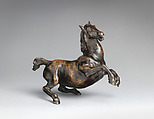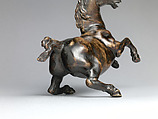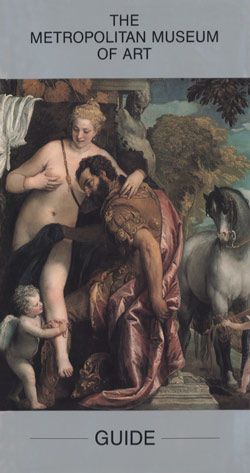Rearing horse
Not on view
Leonardo, as is well known, was a frequent if frustrated experimenter with the plastic arts, especially equestrian bronzes. Consequently, any morsel that might reflect his involvement in an enterprise of that ilk invariably elicits attention, as reflected in the vast literature that surrounds the horse and rider in the Szépművészeti Múzeum, Budapest (inv. 5362). The Hungarian Neoclassical sculptor István Ferenczy acquired it in Rome between 1818 and 1824 as an ancient Greek bronze, and in 1914 it was purchased by the Budapest museum together with other distinguished bronzes from his collection. In 1918, the curator there proposed that it might have been cast from figures modeled in wax or clay by Leonardo, pointing to similarities in his drawings of horses and warriors and associating it with the monument to Gian Giacomo Trivulzio, which never advanced beyond the planning stages.[1] Those conclusions were eagerly accepted after The Met purchased the present horse, “a later and more perfect answer to Leonardo’s problem of equestrian composition.”[2] It was shown at the Albright-Knox Art Gallery in Buffalo in 1937 in a pathbreaking exhibition of bronzes in U.S. collections. It must be admitted that the present author did not get much closer to the mark when writing about the bronze for an exhibition at the Galerie des Beaux-Arts, Bordeaux, in 1981.
Our horse has been exhibited together with the Budapest group twice, at the Szépművészeti Múzeum in 1969 and at the National Gallery of Art, Washington, D.C., in 2009. Following the Budapest showing, Mária Aggházy aired various cntheories, including identification of the Budapest work as the relic of a Leonardo project glorifying François I of France.[3] Neither exhibition had a true catalogue, but the National Gallery team produced a follow-up article analyzing the bronzes and demonstrating the hopelessness of defending the New York horse as a Renaissance work.[4] X-radiography shows that the walls of the cast are very thin, and the elements inside include what look to be modern screws. Worst of all, our rampant “stallion” has no sex organs.
A horse in the Hunt Museum, Limerick, was added to the exhibitions in both Budapest and Washington.[5] Its earliest provenance dates to 1966. Others have emerged, all with limp manes and tails like the Hunt and Met pieces. One was in the collection of the journalist Pierre Jeannerat, London, by 1934, and another was auctioned in 1975.[6] The latter two are mirror inversions of the Budapest and Met compositions. It is unsettling that all of these derivatives of the Budapest group, again like ours, boast little in the way of provenance.
As for the Budapest horse, National Gallery conservators proved that its alloy is the same as that of its rider. The patina, like other, better bronzes from Ferenczy, has an “archaeological” green hue. The jury is still out for the Budapest group. One objection could be the extraordinarily powerful unity that binds the tiny warrior, with his sucked-in belly, to his flailing charger in a spirited demonstration that, if Renaissance, is certainly prophetic of Romanticism. Others are merely technical, such as the separately cast square plug inserted in the mount’s rump, positioning the tail upside down, a trait corrected in all the other horses. A recent attribution to Giovanni Francesco Rustici is unhelpful.[7]
-JDD
Footnotes
(For key to shortened references see bibliography in Allen, Italian Renaissance and Baroque Bronzes in The Metropolitan Museum of Art. NY: The Metropolitan Museum of Art, 2022.)
1. Meller 1916.
2. Letter from Paul S. Harris to Joseph Breck, May 24, 1933, MMA Archives.
3. Aggházy 1972 and 1989.
4. Sturman et al. 2015. See also Luchs et al. 2018. Actually, based on radiography and composition, Richard Stone had noted the problems a decade earlier and dated our horse to the late nineteenth or early twentieth century. R. Stone/TR, October 26, 2005. XRF analysis identified the alloy as a brass.
5. Sturman et al. 2015, pp. 36–38, noting that it is smaller than the other two and from a different workshop.
6. See Jeannerat 1934; Sotheby’s, London, July 5, 1990, lot 106. The second horse was at Lempertz, Cologne, November 20–22, 1975, lot 1770 (unattributed). Still others sold in recent years are listed by Sturman et al. 2015, p. 43 n. 16.
7. Pietro C. Marani in Mozzati et al. 2010, pp. 101–3.
8. As per a photograph dated 1921–22 in ESDA/OF.
Due to rights restrictions, this image cannot be enlarged, viewed at full screen, or downloaded.
This artwork is meant to be viewed from right to left. Scroll left to view more.






